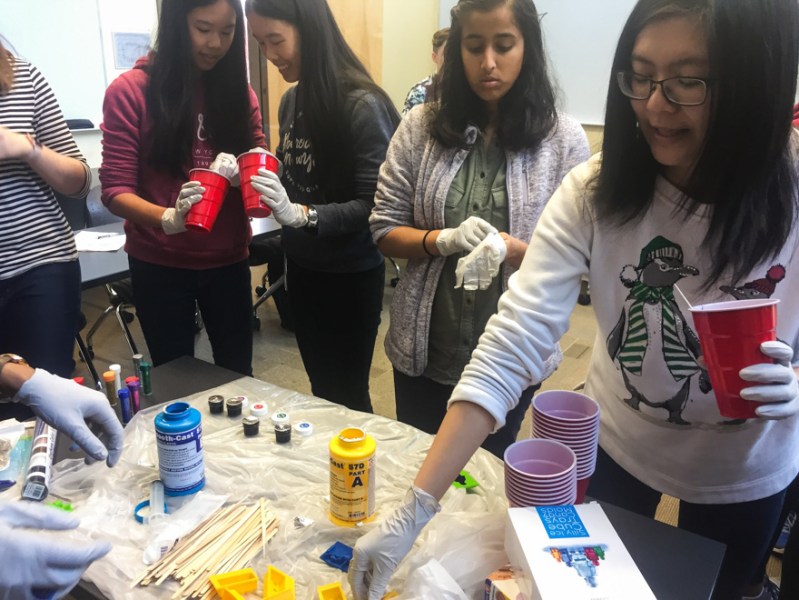On Dec. 1, Stanford’s Society of Women Engineers (SWE) will kick off its pilot program for high school students, Outreach Among Sophomores in Engineering and Science (OASES).
About 10 to 15 female high school sophomores will make their way to campus to meet with Stanford students representing all class years and a diverse variety of engineering disciplines. These female engineering students will mentor the sophomores throughout the year-long program.
“It’s really awesome to see this coming together [and to see Stanford students] working towards a common goal of sharing their passion for science,” said Namita Nabar ’19, one of the co-directors of SWE’s K-12 STEM Outreach.
SWE has already established one-day outreach events, such as Girls Engineering the Future, for K-12 students to come to Stanford and get a brief overview of the campus as well as engineering and STEM at the University.
“We’ve always been very keen on reaching out to K-12 kids,” said Alicia D’Souza ’19, another co-director of K-12 STEM Outreach. “[The one-day outreach events are] a really great opportunity to introduce them to engineering and Stanford overall.”
But the idea to plan and launch OASES was born out of a desire to create longer-lasting impact, especially among high school sophomores.
“We felt that [during] freshman year, kids were trying to get their feel for what high school would be like, and then junior and senior year they were really quite busy,” D’Souza said. “[Sophomore year] is a really critical year where we felt they would have time to be part of our program, and also our information would be meaningful to them as they start looking towards the next steps.”
SWE Outreach Mentorship Chair and OASES leader Eva Frankel ’20 said that she has encountered a different set of challenges in organizing OASES than with other SWE outreach events.
“I think it’s been a challenge to create a vision for the program that feels both useful to the girls and also …practical,” Frankel said.
According to Frankel, SWE has had to put a lot of thought into how big the program will be initially, what speakers to bring, how to effectively pair up mentors and mentees and how to deal with attrition if mentors or mentees drop out.
“All of these are brand new problems that SWE had never had to deal with before because we’ve never had a long-running mentorship program,” Frankel said.
An initial strategy for SWE has been to keep the program small and only recruit students from two schools, Los Altos High School and American High School in Fremont.
“We want to make sure that we provide enough individual attention to each girl [and] that every single person is paired with their best match,” Frankel said.
The sophomores will visit campus five times throughout the duration of the program. SWE is providing reimbursement for public transportation and free breakfast in order to make it accessible for the high school students.
“[We aim to] give them an immersive look into what their future could be like in engineering and STEM,” Nabar said.
To recruit and match mentees with mentors, SWE outreach has been in close contact with teachers at the high schools and has sent out interest forms for the sophomores to fill out with their current inclinations and passions. The Stanford students interested in mentoring also fill out a form with their area of study and their interests. In order to participate, Stanford students must also fulfill the two Student Activities and Leadership (SAL) requirements, a background check and training on working with minors.
Additionally, according to Frankel, the mentorship prerequisites act as a filter to make sure that mentors getting involved are truly committed. SWE has also already put in place backup plans in case mentor-mentee pairs do not work out.
“We have an outreach committee that’s working on programming for these events,” said Frankel. “So I think we would definitely have girls willing to step up to the plate who are … really committed to this project but don’t currently have mentees.”
The program aims to ensure the relationships last through the program and into the future.
“We want the mentee to have this big sister that’s always available to answer questions or worries, any concerns a high schooler might have as she gets ready to apply to college,” Nabar said.
While the focus for SWE outreach is ensuring the success of this year’s pilot program, the group is hoping to grow OASES in the years to come.
“We really hope to grow those numbers … maybe reach out to more schools and just try and broaden our impact,” D’Souza said. “I have a vision for reaching out to communities beyond the Bay Area. That may be less feasible because we wouldn’t be able to bring them to campus.”
Frankel also mentioned the possibility of having the mentees come back to campus as juniors as well as having a new sophomore class, but she emphasized that future developments will depend on what feedback they receive from all the parties involved.
For now, the SWE core is focusing on making this year’s program successful and providing a growing experience for everyone involved, especially the high school mentees.
“We were looking to do something more impactful,” Nabar said. “We wanted to be there to enforce that engineering was definitely an option regardless of your background and regardless of what socioeconomic status you are.”
Contact Andrea Villa at acvilla ‘at’ stanford.edu.
